A Hybrid Voronoi Tessellation/Genetic Algorithm Approach for the Deployment of Drone-Based Nodes of a Self-Organizing Wireless Sensor Network (WSN) in Unknown and GPS Denied Environments
Abstract
1. Introduction
Motivation, Objectives and Goals
- The work presented in this paper is guided by three main goals:
- To design a novel hybrid collaboration between our previous BISON algorithm and a GA, with the aim of further enhancing the performance of nodes in a WSN;
- To evaluate and compare the WSN service and deployment performances of different GA/BISON combinations;
- To study the robustness and resilience of GA-BISON approaches when deployed in dynamic environments and to compare the outcomes of this investigation with the performance of the original BISON algorithm.
- The main contributions of this article over the state of the art are:
- We introduce a hybrid approach that augments the Voronoi based BISON algorithm with a genetic algorithm (Algorithm 1 on page 8). Two variations of the new approach are proposed; the respective algorithms (Algorithms 2 and 3 are provided on pages 10 and 11.
- We measure and compare the effects of adding the GA to BISON in general and compared the original to the two (new) hybrid algorithms. Our findings, indicating when and to which end each algorithm should best be used, are summarized in Table 5 on page 20.
- We evaluate all three approaches for simple and complex scenarios (cf. Section 4.2 for performance measures; cf. Section 4.3 for parameter space exploration). The results are presented and discussed in Section 5.1.
- As the presence of noise has unexpected beneficial effects, we also performed a noise coherence analysis, the outcome of which is provided in Section 5.2.
2. Background and Preliminaries
2.1. Problem Statement and Outlook for the Approach
2.2. Nature-Inspired Heuristics to Improve Voronoi Tessellations
2.2.1. Frequently Used Nature-Inspired Heuristics for WSN
Particle Swarm Optimization (PSO)
Genetic Algorithms (GA)
Ant Colony Optimization (ACO)
2.2.2. Motivating Our Decision to Chose GAs over PSO
- GAs generate candidate solutions based exclusively on information available to a node locally.
- A GA only requires communication with its neighboring WSN nodes (as opposed to all).
2.3. BISON Algorithm: A Quick Review and Overview
3. The GA-BISON Approach
| Algorithm 1:basic Genetic Algorithm. Pseudo-code for the general genetic algorithm, used by BISON FixedNodes (in line 9 of Algorithm 2) and conditional (in line 10 of Algorithm 3). The algorithm takes the following input: r (the number of nodes to consider), (the number of solutions to generate per node), (the population size), (the number of iterations) and (the mutation rate). The output of the algorithm is the solution s. |
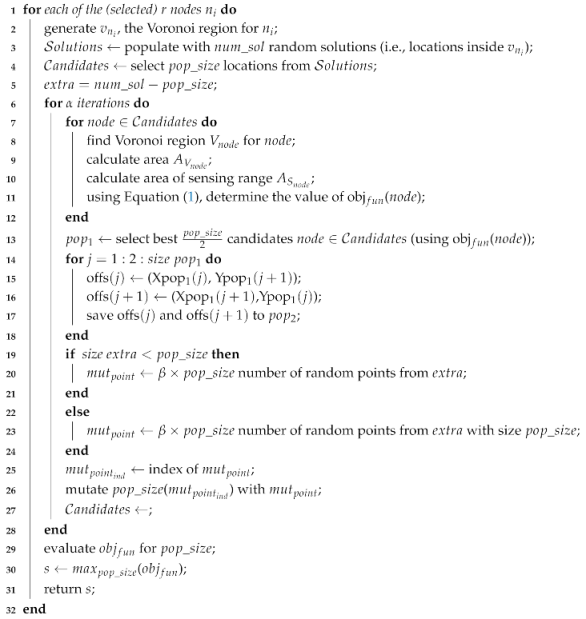 |
3.1. Basic Modeling Choices
3.1.1. Basic Modeling Decisions for Drone-Swarm Based Indoor WSN Deployment
3.1.2. Basic Modeling Choices for the Generic Algorithm
- WHERE to look for (new) candidate locations: The GA will only consider locations inside the node’s confined Voronoi region. The motivation for this is that, as shown in Figure 1, we are certain that these locations are known to the node. Given this, we can simply generate random points within the area as potential candidate solutions (depicted by red crosses in Figure 2).
- HOW to compare the quality of candidate locations: While most objective functions in the literature focus on a single optimization problem, such as coverage, connectivity, or energy consumption [73,74,75] we use multi-objective optimization. The few multi-optimization objective functions in the literature, e.g., combine coverage with either energy consumption (distance traveled) or with inter-node connectivity [76,77,92]. Our objective function combines three parameters: coverage (measured—for each candidate location—as the ratio between the area of the Voronoi region and the area defined by the sensing range of node [93]), connectivity (the number of neighboring nodes), and energy cost (measured as the distance to travel).
| Algorithm 2:GA-BISON (fixed nodes). The algorithm takes the following input: a set of nodes to which to apply the algorithm to, (a threshold for minimum coverage to be achieved before the algorithm is used, initially set to 50), (a termination criterion on the observed node movement, set to ) and (a second termination criterion on iterative coverage improvements, set to 15). |
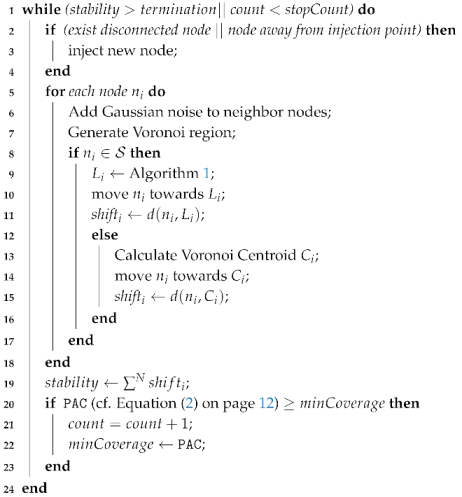 |
- (used line 9 in Algorithm 1) is the node’s Voronoi area;
- (used in line 10 in Algorithm 1) is the node’s sensing range area;
- is the distance between the new candidate () and the existing () location;
- is the number of neighbors at the new location;
- is the number of neighbors at the existing location.
3.2. The Genetic Algorithm—Basic Algorithm
- Initialization: Initially, (the GA population size) candidate solutions (locations) inside the respective Voronoi region are generated randomly (line 3 of Algorithm 1 on page 8) and evaluated using the objective function (line 1). Based upon this, the best solutions are kept as parents for the next GA generation (line 3).
- Genetic Operators: Two standard operators, cross-over (lines 15–17) and mutation (line 26) are used. The crossover step is implemented as a single-point crossover: two parent solutions are chosen at random and their y-axis values are switched, thereby generating two new offsprings. This process is repeated times (because parent and offspring generation are of the same size). To ensure diversity, mutation is applied to the offspring generation.
- Selection: the best from the parent and offspring generation are kept as the next generation (line 27); the best member of this generation becomes the new sensor position.
| Algorithm 3:GA-BISON (conditional). The algorithm takes the following input: (a threshold value below which the GA is used, set to 4), (a threshold for minimum coverage to be achieved before the algorithm is used, initially set to 50), (a termination criterion on the observed node movement, set to ) and (a second termination criterion on iterative coverage improvements, set to 15). |
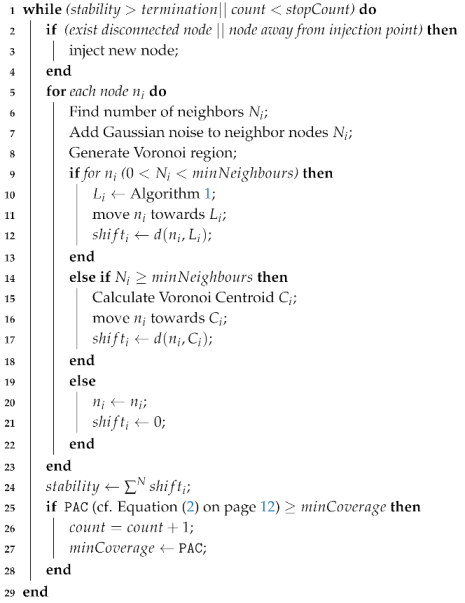 |
3.3. The Genetic Algorithm—GA-BISON (Fixed Nodes)
3.4. The Genetic Algorithm—GA-BISON (Conditional)
4. Setup and Performance Measures
4.1. Simulation Setup
4.2. Evaluation Metrics
- The number of simulation steps required to achieve optimum performance (full coverage). This is a straight forward metric to measure the speed with which the algorithms converge on the optimal solution. Since the execution of the algorithms is happening on each device separately and under the assumption that the actual flying operation takes more time than the calculations, comparing the performance on the basis of the simulation steps required to achieve full coverage enables us to relate the approaches to one another with regard to deployment speed.
- The percentage area coverage (PAC): following from the previous metric, the coverage achieved is the primary measure for performance. By considering not only the moment when this is fully achieved, but also its development over time until then, we can compare the approaches progress during execution. For the measure PAC, the coverage of 100,000 sampling points inside the environment into which the swarm is released is recorded. Given these, PAC is calculated:The sampling points are drawn from the accessible area inside the environment, meaning that pillars/signal scattering objects are excluded. This is of relative little impact here, but for investigations on environments with a larger number of walls and objects (not included in this report) this makes a significant difference. The area coverage is expressed as a percentage precisely because this allows us to compare the results from different environments.
- The cumulative distance traveled (CDT): after considering the steps to completion and the evolution of coverage; until then we use CDT as a measure for comparing the physical effort required (i.e., the cost) to do so. CDT is calculated as the sum of all node-movements over time:with the sum of the combined node movements during a time step, defined recursively as:with the absolute Euclidean distance between the previous location of node and its current one, where is the injection point at time .
4.3. GA Parameter Settings
4.3.1. Population Size (Figure 4, Top Row)
4.3.2. Number of Iterations (Figure 4, Middle Row)
4.3.3. Mutation Rate (Figure 4, Bottom Row)
4.4. The Number of Fixed Nodes in BISON-GA (Fixed Nodes)
5. Results and Discussion
5.1. Performance Evaluation of the Algorithms
5.1.1. Performance Evaluation—Obstacle-Free Environment
5.1.2. Performance Evaluation—Obstacle-Rich Environment
5.1.3. Obstacle-Free versus Obstacle-Rich Environment
5.1.4. The Impact of Noise
5.1.5. Summary and Discussion
5.2. Noise Coherence Analysis
5.2.1. Motivation
5.2.2. Modeling Node—Diffusion and—Drift
5.2.3. The Impact of Noise
The Impact of Noise in General
The Impact of Noise: Fixed Nodes versus Conditional
5.2.4. Summary
6. Conclusions and Future Work Plan
Author Contributions
Funding
Acknowledgments
Conflicts of Interest
Abbreviations
| ACO | Ant Colony Optimization |
| CDT | Cumulative Distance Traveled |
| GA | Genetic Algorithm |
| GL | Goods Delivery/Logistics |
| INT | Surveillance |
| PAC | Percentage Area Coverage |
| PSO | Particle Swarm Optimization |
| RS | Remote Sensing |
| RTM | Real-Time Monitoring |
| SAR | Search and Rescue |
| SI | Structural Inspection |
| UAV | Unmanned Aerial Vehicle |
| WAN | Wireless Access Networks |
| WSN | Wireless Sensing Networks |
References
- Giyenko, A.; Cho, Y.I. Intelligent UAV in smart cities using IoT. In Proceedings of the 2016 16th International Conference on Control, Automation and Systems (ICCAS), Gyeongju, Korea, 16–19 October 2016; pp. 207–210. [Google Scholar] [CrossRef]
- Giyenko, A.; Cho, Y.I. Intelligent Unmanned Aerial Vehicle Platform for Smart Cities. In Proceedings of the 2016 Joint 8th International Conference on Soft Computing and Intelligent Systems (SCIS) and 17th International Symposium on Advanced Intelligent Systems (ISIS), Sapporo, Japan, 25–28 August 2016; pp. 729–733. [Google Scholar] [CrossRef]
- Chen, M.; Hu, Q.; Mackin, C.; Fisac, J.F.; Tomlin, C.J. Safe platooning of unmanned aerial vehicles via reachability. In Proceedings of the 2015 54th IEEE Conference on Decision and Control (CDC), Osaka, Japan, 15–18 December 2015; pp. 4695–4701. [Google Scholar] [CrossRef][Green Version]
- Nakata, R.; Clemens, S.; Lee, A.; Lubecke, V. RF techniques for motion compensation of an Unmanned Aerial Vehicle for remote radar life sensing. In Proceedings of the 2016 IEEE MTT-S Int. Microwave Symp. (IMS), San Francisco, CA, USA, 22–27 May 2016; pp. 1–4. [Google Scholar] [CrossRef]
- Valente, J.; Sanz, D.; Barrientos, A.; del Cerro, J.; Ribeiro, A.; Rossi, C. An Air-Ground Wireless Sensor Network for Crop Monitoring. Sensors 2011, 11, 6088–6108. [Google Scholar] [CrossRef]
- Conesa-Muñoz, J.; Valente, J.; Del Cerro, J.; Barrientos, A.; Ribeiro, A. A Multi-Robot Sense-Act Approach to Lead to a Proper Acting in Environmental Incidents. Sensors 2016, 16. [Google Scholar] [CrossRef] [PubMed]
- Pauner, C.; Kamara, I.; Viguri, J. Drones. Current challenges and standardisation solutions in the field of privacy and data protection. In Proceedings of the 2015 ITU Kaleidoscope: Trust in the Information Society (K-2015), Barcelona, Spain, 9–11 December 2015; pp. 1–7. [Google Scholar] [CrossRef]
- Al-Kaff, A.; Madridano, Á.; Campos, S.; García, F.; Martín, D.; de la Escalera, A. Emergency Support Unmanned Aerial Vehicle for Forest Fire Surveillance. Electronics 2020, 9. [Google Scholar] [CrossRef]
- Borreguero, D.; Velasco, O.; Valente, J. Experimental Design of a Mobile Landing Platform to Assist Aerial Surveys in Fluvial Environments. Appl. Sci. 2018, 9. [Google Scholar] [CrossRef]
- Erdelj, M.; Natalizio, E.; Chowdhury, K.R.; Akyildiz, I.F. Help from the Sky: Leveraging UAVs for Disaster Management. IEEE Pervasive Comput. 2017, 16, 24–32. [Google Scholar] [CrossRef]
- Khamis, A.; Hussein, A.; Elmogy, A. Multi-robot Task Allocation: A Review of the State-of-the-Art. In Cooperative Robots and Sensor Networks 2015; Koubâa, A., Martínez-de Dios, J., Eds.; Springer International Publishing: Cham, Switzerland, 2015; pp. 31–51. [Google Scholar] [CrossRef]
- Khuwaja, A.A.; Chen, Y.; Zhao, N.; Alouini, M.; Dobbins, P. A Survey of Channel Modeling for UAV Communications. IEEE Commun. Surv. Tutor. 2018, 20, 2804–2821. [Google Scholar] [CrossRef]
- Khawaja, W.; Guvenc, I.; Matolak, D.W.; Fiebig, U.; Schneckenberger, N. A Survey of Air-to-Ground Propagation Channel Modeling for Unmanned Aerial Vehicles. IEEE Commun. Surv. Tutor. 2019. [Google Scholar] [CrossRef]
- Mozaffari, M.; Saad, W.; Bennis, M.; Nam, Y.; Debbah, M. A Tutorial on UAVs for Wireless Networks: Applications, Challenges, and Open Problems. IEEE Commun. Surv. Tutor. 2019. [Google Scholar] [CrossRef]
- Hossein Motlagh, N.; Taleb, T.; Arouk, O. Low-Altitude Unmanned Aerial Vehicles-Based Internet of Things Services: Comprehensive Survey and Future Perspectives. IEEE Internet Things J. 2016, 3, 899–922. [Google Scholar] [CrossRef]
- Gupta, L.; Jain, R.; Vaszkun, G. Survey of Important Issues in UAV Communication Networks. IEEE Commun. Surv. Tutor. 2016, 18, 1123–1152. [Google Scholar] [CrossRef]
- Hayat, S.; Yanmaz, E.; Muzaffar, R. Survey on Unmanned Aerial Vehicle Networks for Civil Applications: A Communications Viewpoint. IEEE Commun. Surv. Tutor. 2016, 18, 2624–2661. [Google Scholar] [CrossRef]
- Shakhatreh, H.; Sawalmeh, A.H.; Al-Fuqaha, A.I.; Dou, Z.; Almaita, E.K.; Khalil, I.M.; Othman, N.S.; Khreishah, A.; Guizani, M. Unmanned Aerial Vehicles (UAVs): A Survey on Civil Applications and Key Research Challenges. IEEE Access 2019, 7, 48572–48634. [Google Scholar] [CrossRef]
- Hildmann, H.; Kovacs, E. Review: Using Unmanned Aerial Vehicles (UAVs) as Mobile Sensing Platforms (MSPs) for Disaster Response, Civil Security and Public Safety. Drones 2019, 3. [Google Scholar] [CrossRef]
- Hildmann, H.; Kovacs, E.; Saffre, F.; Isakovic, A.F. Nature-Inspired Drone Swarming for Real-Time Aerial Data-Collection Under Dynamic Operational Constraints. Drones 2019, 3. [Google Scholar] [CrossRef]
- Khawaja, W.; Guvenc, I.; Matolak, D. UWB Channel Sounding and Modeling for UAV Air-to-Ground Propagation Channels. In Proceedings of the 2016 IEEE Global Communications Conference (GLOBECOM), Washington, DC, USA, 4–8 December 2016; pp. 1–7. [Google Scholar] [CrossRef]
- Rupasinghe, N.; Ibrahim, A.S.; Guvenc, I. Optimum Hovering Locations with Angular Domain User Separation for Cooperative UAV Networks. In Proceedings of the 2016 IEEE Global Communications Conference (GLOBECOM), Washington, DC, USA, 4–8 December 2016; pp. 1–6. [Google Scholar] [CrossRef]
- Kobayashi, T.; Matsuoka, H.; Betsumiya, S. Flying Communication Server in case of a Largescale Disaster. In Proceedings of the 2016 IEEE 40th Annual Computer Software and Applications Conference (COMPSAC), Atlanta, GA, USA, 10–14 June 2016; Volume 2, pp. 571–576. [Google Scholar] [CrossRef]
- Giagkos, A.; Wilson, M.S.; Tuci, E.; Charlesworth, P.B. Comparing approaches for coordination of autonomous communications UAVs. In Proceedings of the 2016 International Conference on Unmanned Aircraft Systems (ICUAS), Arlington, VA, USA, 7–10 June 2016; pp. 1131–1139. [Google Scholar] [CrossRef]
- Bupe, P.; Haddad, R.; Rios-Gutierrez, F. Relief and emergency communication network based on an autonomous decentralized UAV clustering network. In Proceedings of the SoutheastCon 2015, Fort Lauderdale, FL, USA, 9–12 April 2015; pp. 1–8. [Google Scholar] [CrossRef]
- Guevara, K.; Rodriguez, M.; Gallo, N.; Velasco, G.; Vasudeva, K.; Guvenc, I. UAV-based GSM network for public safety communications. In Proceedings of the SoutheastCon 2015, Fort Lauderdale, FL, USA, 9–12 April 2015; pp. 1–2. [Google Scholar] [CrossRef]
- Hayajneh, A.M.; Zaidi, S.A.R.; McLernon, D.C.; Ghogho, M. Drone Empowered Small Cellular Disaster Recovery Networks for Resilient Smart Cities. In Proceedings of the 2016 IEEE International Conference on Sensing, Communication and Networking (SECON Workshops), London, UK, 27 June 2016; pp. 1–6. [Google Scholar] [CrossRef][Green Version]
- Mase, K.; Okada, H. Message communication system using unmanned aerial vehicles under large-scale disaster environments. In Proceedings of the 2015 IEEE 26th Annual International Symposium on Personal, Indoor, and Mobile Radio Communications (PIMRC), Hong Kong, China, 30 August–2 September 2015; pp. 2171–2176. [Google Scholar] [CrossRef]
- Madany, Y.M.; Elkamchouchi, H.M.; Ahmed, M.M. Modelling and Simulation of Robust Navigation for Unmanned Air Systems (UASs) Based on Integration of Multiple Sensors Fusion Architecture. In Proceedings of the 2013 European Modelling Symposium, Manchester, UK, 20–22 November 2013; pp. 719–724. [Google Scholar] [CrossRef]
- De Albuquerque, J.C.; de Lucena, S.C.; Campos, C.A.V. Evaluating data communications in natural disaster scenarios using opportunistic networks with Unmanned Aerial Vehicles. In Proceedings of the 2016 IEEE 19th International Conference on Intelligent Transportation Systems (ITSC), Rio de Janeiro, Brazil, 1–4 November 2016; pp. 1452–1457. [Google Scholar] [CrossRef]
- Zhang, Y.; Ren, Z.; Liu, L.; Wei, C.; Yin, C. Design for a fast high precision UAV power emergency relief system. In Proceedings of the 4th Int. Conf. on Applied Robotics for the Power Industry (CARPI), Jinan, China, 11–13 October 2016; pp. 1–4. [Google Scholar] [CrossRef]
- Li, Y.; He, L.; Ye, X.; Guo, D. Geometric correction algorithm of UAV remote sensing image for the emergency disaster. In Proceedings of the 2016 IEEE International Geoscience and Remote Sensing Symposium (IGARSS), Beijing, China, 10–15 July 2016; pp. 6691–6694. [Google Scholar] [CrossRef]
- Saponara, S.; Neri, B. Radar sensor signal acquisition and 3D FFT processing for smart mobility surveillance systems. In Proceedings of the 2016 IEEE Sensors Applications Symposium (SAS), Catania, Italy, 20–22 April 2016; pp. 1–6. [Google Scholar] [CrossRef]
- Erdelj, M.; Natalizio, E. UAV-assisted disaster management: Applications and open issues. In Proceedings of the 2016 International Conference on Computing, Networking and Communications (ICNC), Kauai, HI, USA, 15–18 February 2016; pp. 1–5. [Google Scholar] [CrossRef]
- Reardon, C.; Fink, J. Air-ground robot team surveillance of complex 3D environments. In Proceedings of the 2016 IEEE International Symposium on Safety, Security, and Rescue Robotics (SSRR), Lausanne, Switzerland, 23–27 October 2016; pp. 320–327. [Google Scholar] [CrossRef]
- Skinnemoen, H. UAV & satellite communications live mission-critical visual data. In Proceedings of the 2014 IEEE International Conference on Aerospace Electronics and Remote Sensing Technology, Yogyakarta, Indonesia, 13–14 November 2014; pp. 12–19. [Google Scholar] [CrossRef]
- Inata, H.; Say, S.; Ando, T.; Liu, J.; Shimamoto, S. Unmanned aerial vehicle based missing people detection system employing phased array antenna. In Proceedings of the 2016 IEEE Wireless Communications and Networking Conference, Doha, Qatar, 3–6 April 2016; pp. 1–6. [Google Scholar] [CrossRef]
- Bejiga, M.B.; Zeggada, A.; Melgani, F. Convolutional neural networks for near real-time object detection from UAV imagery in avalanche search and rescue operations. In Proceedings of the 2016 IEEE International Geoscience and Remote Sensing Symposium (IGARSS), Beijing, China, 10–15 July 2016; pp. 693–696. [Google Scholar] [CrossRef]
- Shariat, A.; Tizghadam, A.; Leon-Garcia, A. An ICN-based publish-subscribe platform to deliver UAV service in smart cities. In Proceedings of the 2016 IEEE Conference on Computer Communications Workshops (INFOCOM WKSHPS), San Francisco, CA, USA, 10–14 April 2016; pp. 698–703. [Google Scholar] [CrossRef]
- Scherer, J.; Rinner, B. Persistent multi-UAV surveillance with energy and communication constraints. In Proceedings of the 2016 IEEE International Conference on Automation Science and Engineering (CASE), Fort Worth, TX, USA, 21–25 August 2016; pp. 1225–1230. [Google Scholar] [CrossRef]
- Luo, C.; Nightingale, J.; Asemota, E.; Grecos, C. A UAV-Cloud System for Disaster Sensing Applications. In Proceedings of the 2015 IEEE 81st Vehicular Technology Conference (VTC Spring), Glasgow, UK, 11–14 May 2015; pp. 1–5. [Google Scholar] [CrossRef]
- Gamba, M.T.; Ugazio, S.; Marucco, G.; Pini, M.; Presti, L.L. Light weight GNSS-based passive radar for remote sensing UAV applications. In Proceedings of the 2015 IEEE 1st International Forum on Research and Technologies for Society and Industry Leveraging a better tomorrow (RTSI), Turin, Italy, 16–18 September 2015; pp. 341–348. [Google Scholar] [CrossRef]
- Ezequiel, C.A.F.; Cua, M.; Libatique, N.C.; Tangonan, G.L.; Alampay, R.; Labuguen, R.T.; Favila, C.M.; Honrado, J.L.E.; Caños, V.; Devaney, C.; et al. UAV aerial imaging applications for post-disaster assessment, environmental management and infrastructure development. In Proceedings of the 2014 International Conference on Unmanned Aircraft Systems (ICUAS), Orlando, FL, USA, 27–30 May 2014; pp. 274–283. [Google Scholar] [CrossRef]
- Morito, T.; Sugiyama, O.; Kojima, R.; Nakadai, K. Partially Shared Deep Neural Network in sound source separation and identification using a UAV-embedded microphone array. In Proceedings of the 2016 IEEE/RSJ International Conference on Intelligent Robots and Systems (IROS), Daejeon, Korea, 9–14 October 2016; pp. 1299–1304. [Google Scholar] [CrossRef]
- Hussein, A.; Al-Kaff, A.; de la Escalera, A.; Armingol, J.M. Autonomous indoor navigation of low-cost quadcopters. In Proceedings of the 2015 IEEE International Conference on Service Operations And Logistics, And Informatics (SOLI), Hammamet, Tunisia, 15–17 November 2015; pp. 133–138. [Google Scholar]
- Maraiya, K.; Kant, K.; Gupta, N. Application based Study on Wireless Sensor Network. Int. J. Comput. Appl. 2011, 21, 9–15. [Google Scholar] [CrossRef]
- Ko, J.; Lim, J.; Chen, Y.; Musvaloiu-E, R.; Terzis, A.; Masson, G.; Gao, T.; Destler, W.; Selavo, L.; Dutton, R. BMEDiSN: Medical emergency detection in sensor networks. ACM Trans. Embed. Comput. Syst. 2010, 10. [Google Scholar] [CrossRef]
- Anand, D.G.; Giriprasad, M.N. Energy Efficient Coverage Problems in Wireless Ad Hoc Sensor Networks; Zenodo: Genèva, Switzerland, 2018. [Google Scholar] [CrossRef]
- Ingelrest, F.; Barrenetxea, G.; Schaefer, G.; Vetterli, M.; Couach, O.; Parlange, M. SensorScope: Application-Specific Sensor Network for Environmental Monitoring. ACM Trans. Sen. Netw. 2010, 6. [Google Scholar] [CrossRef]
- Valente, J.; Almeida, R.; Kooistra, L. A Comprehensive Study of the Potential Application of Flying Ethylene-Sensitive Sensors for Ripeness Detection in Apple Orchards. Sensors 2019, 19. [Google Scholar] [CrossRef]
- Valente, J.; Roldán, J.; Garzón, M.; Barrientos, A. Towards Airborne Thermography via Low-Cost Thermopile Infrared Sensors. Drones 2019, 3. [Google Scholar] [CrossRef]
- Aziz, N.; Mohemmed, A.; Daya Sagar, B.S. Particle Swarm Optimization and Voronoi diagram for Wireless Sensor Networks coverage optimization. In Proceedings of the 2007 International Conference on Intelligent and Advanced Systems, Kuala Lumpur, Malaysia, 25–28 November 2007; pp. 961–965. [Google Scholar] [CrossRef]
- Aziz, N.; Mohemmed, A.; Alias, M.Y. A wireless sensor network coverage optimization algorithm based on particle swarm optimization and Voronoi diagram. In Proceedings of the N 2009 International Conference on Networking, Sensing and Control, Okayama, Japan, 26–29 March 2009; pp. 602–607. [Google Scholar] [CrossRef]
- Eledlebi, K.; Ruta, D.; Saffre, F.; Al-Hammadi, Y.; Isakovic, A.F. Autonomous Deployment of Mobile Sensors Network in an Unknown Indoor Environment with Obstacles. In Proceedings of the Genetic and Evolutionary Computation Conference Companion; Association for Computing Machinery: New York, NY, USA, 2018; pp. 280–281. [Google Scholar] [CrossRef]
- Eledlebi, K.; Ruta, D.; Saffre, F.; AlHammadi, Y.; Isakovic, A.F. Voronoi-Based Indoor Deployment of Mobile Sensors Network with Obstacles. In Proceedings of the 2018 IEEE 3rd International Workshops on Foundations and Applications of Self* Systems (FAS*W), Trento, Italy, 3–7 September 2018; pp. 20–21. [Google Scholar]
- Kulkarni, R.V.; Member, S.; Venayagamoorthy, G.K.; Member, S. Particle swarm optimization in wireless-sensor networks: A brief survey. In IEEE Transactions on Systems, Man, and Cybernetics, Part C: Applications and Reviews; IEEE: Piscataway, NJ, USA, 2011; p. 267. [Google Scholar]
- Park, H.; Han, J.; Kim, J. Swarm intelligence-based sensor network deployment strategy. In Proceedings of the IEEE Congress on Evolutionary Computation, Barcelona, Spain, 18–23 July 2010; pp. 1–6. [Google Scholar]
- Nematy, F.; Rahmani, N. Using Voronoi Diagram and Genetic Algorithm to Deploy Nodes in Wireless Sensor Network. Int. J. Soft Comput. Softw. Eng. (JSCSE) 2013, 3, 706–713. [Google Scholar]
- Kumar, M.; Gupta, V. Benefits of using particle swarm optimization and Voronoi diagram for coverage in wireless sensor networks. In Proceedings of the 2017 International Conference on Emerging Trends in Computing and Communication Technologies (ICETCCT), Dehradun, India, 17–18 November 2017; pp. 1–7. [Google Scholar]
- Hassan, R.; Cohanim, B.; de Weck, O. A Comparison of Particle Swarm Optimization and the Genetic Algorithm. In Proceedings of the 46th AIAA/ASME/ASCE/AHS/ASC Structures, Structural Dynamics and Materials Conference, Austin, TX, USA, 18–21 April 2005; Volume 2. [Google Scholar] [CrossRef]
- Qu, Y.; Georgakopoulos, S.V. A centralized algorithm for prolonging the lifetime of wireless sensor networks using Particle Swarm Optimization. In Proceedings of the WAMICON 2012 IEEE Wireless Microwave Technology Conference, Cocoa Beach, FL, USA, 15–17 April 2012; pp. 1–6. [Google Scholar]
- Friedrich, T.; Kotzing, T.; Krejca, M.; Sutton, A. The Compact Genetic Algorithm is Efficient under Extreme Gaussian Noise. IEEE Trans. Evol. Comput. 2016, 21, 477–490. [Google Scholar] [CrossRef]
- Fan, Z.W. Network Coverage Optimization Strategy in Wireless Sensor Networks Based on Particle Swarm Optimization. Bachelor’s Thesis, University of Gavle, Gavle, Sweden, 2011. Dissertation No. Tex110531. [Google Scholar]
- Yoon, Y.; Kim, Y.H. An Efficient Genetic Algorithm for Maximum Coverage Deployment in Wireless Sensor Networks. IEEE Trans. Cybern. 2013, 43. [Google Scholar] [CrossRef]
- Liu, X. Sensor Deployment of Wireless Sensor Networks Based on Ant Colony Optimization with Three Classes of Ant Transitions. IEEE Commun. Lett. 2012, 16, 1604–1607. [Google Scholar] [CrossRef]
- Lee, K.; Kim, J. Multiobjective Particle Swarm Optimization With Preference-Based Sort and Its Application to Path Following Footstep Optimization for Humanoid Robots. IEEE Trans. Evol. Comput. 2013, 17, 755–766. [Google Scholar] [CrossRef]
- Naeim, R.; Nematy, F.; Rahmani, A.; Hosseinzadeh, M. Node placement for maximum coverage based on voronoi diagram using genetic algorithm in wireless sensor networks. Aust. J. Basic Appl. Sci. 2011, 5, 3221–3232. [Google Scholar]
- Zou, J.; Gundry, S.; Kusyk, J.; Sahin, C.S.; Uyar, M.U. Bio-inspired and Voronoi-based Algorithms for Self-positioning of Autonomous Vehicles in Noisy Environments. In Proceedings of the 8th International Conference on Bioinspired Information and Communications Technologies; ICST (Institute for Computer Sciences, Social-Informatics and Telecommunications Engineering): Brussels, Belgium, 2014; pp. 17–22. [Google Scholar] [CrossRef]
- Marbate, P.; Jaini, P. Role of Voronoi Diagram Approach in Path Planning. Int. J. Eng. Sci. Technol. (IJEST) 2013, 5, 527. [Google Scholar]
- Cortes, J.; Martinez, S.; Karatas, T.; Bullo, F. Coverage control for mobile sensing networks. IEEE Trans. Robot. Autom. 2004, 20, 243–255. [Google Scholar] [CrossRef]
- Qu, Y.; Georgakopoulos, S.V. Relocation of wireless sensor network nodes using a genetic algorithm. In Proceedings of the WAMICON 2011 Conference Proceedings, Clearwater Beach, FL, USA, 18–19 April 2011; pp. 1–5. [Google Scholar]
- Bhondekar, A.P.; Vig, R.; Singla, M.L.; Ghanshyam, C.; Kapur, P. Genetic Algorithm Based Node Placement Methodology For Wireless Sensor Networks. In Proceedings of the International Multiconference of Engineers and Computer Scientists, Hong Kong, 18–20 March 2009. [Google Scholar]
- Kaur, S.; Uppal, R.S. Dynamic deployment of homogeneous sensor nodes using genetic algorithm with maximum coverage. In Proceedings of the 2015 2nd International Conference on Computing for Sustainable Global Development (INDIACom), New Delhi, India, 11–13 March 2015; pp. 470–475. [Google Scholar]
- Norouzi, A.; Zaim, A.H. Genetic Algorithm Application in Optimization of Wireless Sensor Networks. Sci. World J. 2014, 14, 1–15. [Google Scholar] [CrossRef]
- Hosseinirad, S.M.; Basu, S. Wireless sensor network design through genetic algorithm. J. Data Min. 2014, 2, 85–96. [Google Scholar] [CrossRef]
- Romoozi, M.; Vahidipour, M.; Romoozi, M.; Maghsoodi, S. Genetic Algorithm for Energy Efficient and Coverage-Preserved Positioning in Wireless Sensor Networks. In Proceedings of the 2010 International Conference on Intelligent Computing and Cognitive Informatics, Kuala Lumpur, Malaysia, 22–23 June 2010; pp. 22–25. [Google Scholar]
- Tahir, N.H.M.; Atan, F. A Modified Genetic Algorithm Method for Maximum Coverage in Dynamic Mobile Wireless Sensor Networks. J. Basic Appl. Sci. Res. 2016, 6, 26–32. [Google Scholar]
- Pietrabissa, A.; Liberati, F.; Oddi, G. A distributed algorithm for Ad-hoc network partitioning based on Voronoi Tessellation. Ad Hoc Networks 2016, 46, 37–47. [Google Scholar] [CrossRef]
- Blum, C. Ant colony optimization: Introduction and recent trends. Phys. Life Rev. 2005, 2, 353–373. [Google Scholar] [CrossRef]
- Banimelhem, O.; Mowafi, M.; Aljoby, W. Genetic Algorithm Based Node Deployment in Hybrid Wireless Sensor Networks. Commun. Netw. 2013, 5, 273–279. [Google Scholar] [CrossRef]
- Li, Y.; Dong, T.; Bikdash, M.; Song, Y.D. Path Planning for Unmanned Vehicles Using Ant Colony Optimization on a Dynamic Voronoi Diagra. In Proceedings of the 2005 International Conference on Artificial Intelligence, ICAI 2005, Las Vegas, NV, USA, 27–30 June 2005; pp. 716–721. [Google Scholar]
- Trivedi, A.; Srinivasan, D.; Sanyal, K.; Ghosh, A. A Survey of Multiobjective Evolutionary Algorithms Based on Decomposition. IEEE Trans. Evol. Comput. 2017, 21, 440–462. [Google Scholar] [CrossRef]
- Du, Q.; Faber, V.; Gunzburger, M. Centroidal Voronoi Tessellations: Applications and Algorithms. SIAM Rev. 1999, 41, 637–676. [Google Scholar] [CrossRef]
- Abo-Zahhad, M.; Sabor, N.; Sasaki, S.; Ahmed, S.M. A centralized immune-Voronoi deployment algorithm for coverage maximization and energy conservation in mobile wireless sensor networks. Inf. Fusion 2016, 30, 36–51. [Google Scholar] [CrossRef]
- Jabbar, S.; Iram, R.; Minhas, A.A.; Shafi, I.; Khalid, S.; Ahmad, M. Intelligent Optimization of Wireless Sensor Networks through Bio-Inspired Computing: Survey and Future Directions. Int. J. Distrib. Sens. Netw. 2013, 9, 421084. [Google Scholar] [CrossRef]
- Buttar, A.S.; Ali, S.S. Efficient Routing for Maximizing Lifetime using Nature Inspired Algorithm in Wireless Sensor Network. Int. J. Future Revolut. Comput. Sci. Commun. Eng. 2017, 3, 172–176. [Google Scholar]
- Kim, K.S.; Lee, S.; Ting, T.O.; Yang, X.S. Atomic Scheduling of Appliance Energy Consumption in Residential Smart Grids. Energies 2019, 12. [Google Scholar] [CrossRef]
- Fister, I.; Mernik, M.; Brest, J. Hybridization of Evolutionary Algorithms. Evol. Algorithms 2011. [Google Scholar] [CrossRef]
- Brownlee, J. Clever Algorithms: Nature-Inspired Programming Recipes; Lulu.com: Morrisville, NC, USA, 2011. [Google Scholar]
- Ohya, A.; Ohno, T.; Yuta, S. Obstacle detectability of ultrasonic ranging system and sonar map understanding. Robot. Auton. Syst. 1996, 18, 251–257. [Google Scholar] [CrossRef][Green Version]
- Li, F.; Luo, J.; Xin, S.; He, Y. Autonomous deployment of wireless sensor networks for optimal coverage with directional sensing model. Comput. Netw. 2016, 108, 120–132. [Google Scholar] [CrossRef]
- Jia, J.; Chen, J.; Chang, G.; Li, J.; Jia, Y. Coverage Optimization based on Improved NSGA-II in Wireless Sensor Network. In Proceedings of the 2007 IEEE International Conference on Integration Technology, Shenzhen, China, 20–24 March 2007; pp. 614–618. [Google Scholar]
- Zou, J.; Kusyk, J.; Uyar, M.; Gundry, S.; Sahin, C.S. Bio-inspired and Voronoi-based algorithms for self-positioning autonomous mobile nodes. In Proceedings of the MILCOM 2012—2012 IEEE Military Communications Conference, Orlando, FL, USA, 29 October–1 November 2012; pp. 1–6. [Google Scholar] [CrossRef]
- Simon, M.; Alouini, M. Digital Communication Over Fading Channels: A Unified Approach to Performance Analysis; A Wiley Interscience Publication; Wiley: Hoboken, NJ, USA, 2000. [Google Scholar]
- Molisch, A. Wireless Communications; Wiley-IEEE: Hoboken, NJ, USA, 2012. [Google Scholar]
- Sklar, B. Digital Communications: Fundamentals and Applications; Prentice Hall Communications Engineering and Emerging Technologies; Prentice-Hall PTR: Upper Saddle River, NJ, USA, 2001. [Google Scholar]
- Rappaport, T. Wireless Communications: Principles and Practice; Prentice Hall Communications Engineering and Emerging Technologies Series; Prentice-Hall PTR: Upper Saddle River, NJ, USA, 2002. [Google Scholar]
- Eledlebi, K.; Ruta, D.; Saffre, F.; Al-Hammadi, Y.; Isakovic, A. A Model for Self-deployment of Autonomous Mobile Sensor Network in an Unknown Indoor Environment. In Ad Hoc Networks; Springer: Cham, Switzerland, 2018; pp. 208–215. [Google Scholar] [CrossRef]
- Osman, M.; Hussein, A.; Al-Kaff, A.; García, F.; Armingol, J.M. Online Adaptive Covariance Estimation Approach for Multiple Odometry Sensors Fusion. In Proceedings of the 2018 IEEE Intelligent Vehicles Symposium (IV), Changshu, China, 26–30 June 2018; pp. 355–360. [Google Scholar]
- Osman, M.; Hussein, A.; Al-Kaff, A.; García, F.; Cao, D. A Novel Online Approach for Drift Covariance Estimation of Odometries Used in Intelligent Vehicle Localization. Sensors 2019, 19. [Google Scholar] [CrossRef]
- Yates, C.A.; Erban, R.; Escudero, C.; Couzin, I.D.; Buhl, J.; Kevrekidis, I.G.; Maini, P.K.; Sumpter, D.J.T. Inherent noise can facilitate coherence in collective swarm motion. Proc. Natl. Acad. Sci. USA 2009, 106, 5464–5469. [Google Scholar] [CrossRef] [PubMed]
- Zhang, Y.; Gong, Y.; Gao, Y.; Wang, H.; Zhang, J. Parameter-Free Voronoi Neighborhood for Evolutionary Multimodal Optimization. IEEE Trans. Evol. Comput. 2020, 24, 335–349. [Google Scholar] [CrossRef]
- Sosa San Frutos, R.; Al Kaff, A.; Hussein, A.; Madridano, Á.; Martín, D.; de la Escalera, A. ROS-Based Architecture for Multiple Unmanned Vehicles (UXVs) Formation. In Computer Aided Systems Theory—EUROCAST 2019; Moreno-Díaz, R., Pichler, F., Quesada-Arencibia, A., Eds.; Springer International Publishing: Cham, Switzerland, 2020; pp. 11–19. [Google Scholar]
- Boubeta-Puig, J.; Moguel, E.; Sánchez-Figueroa, F.; Hernández, J.; Preciado, J.C. An Autonomous UAV Architecture for Remote Sensing and Intelligent Decision-making. IEEE Internet Comput. 2018, 22, 6–15. [Google Scholar] [CrossRef]
- Stöcker, C.; Bennett, R.; Nex, F.; Gerke, M.; Zevenbergen, J. Review of the Current State of UAV Regulations. Remote. Sens. 2017, 9. [Google Scholar] [CrossRef]

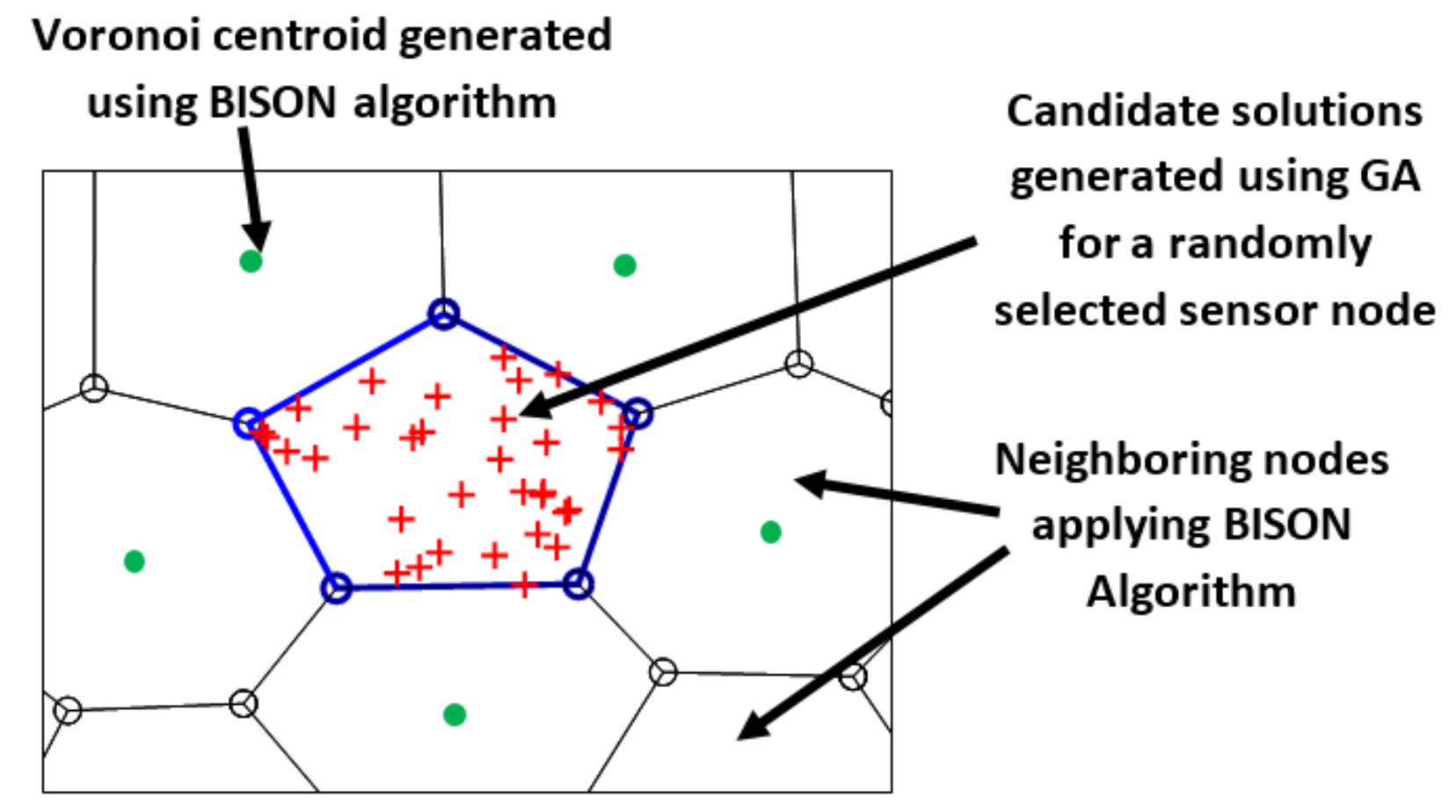
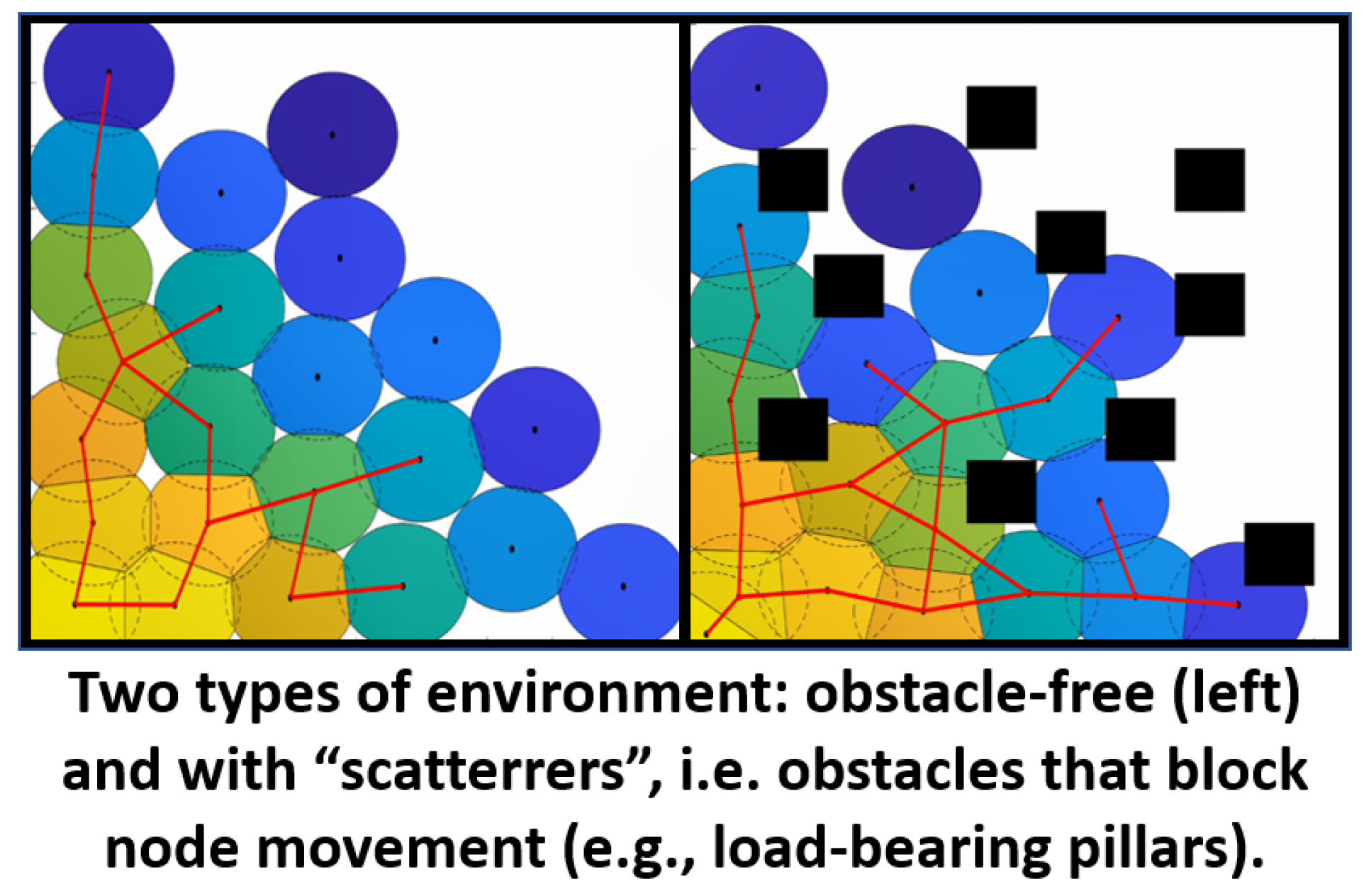
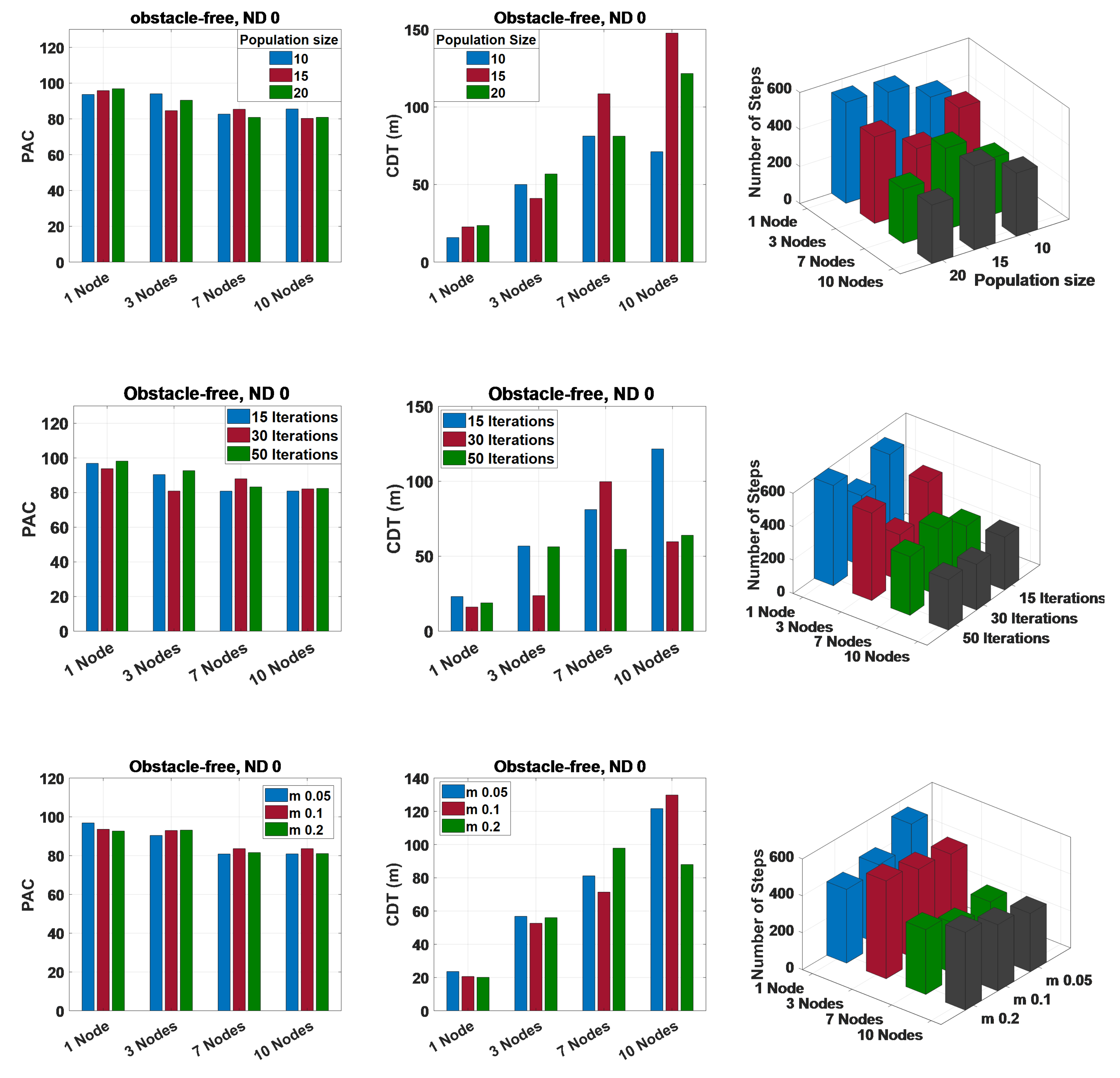


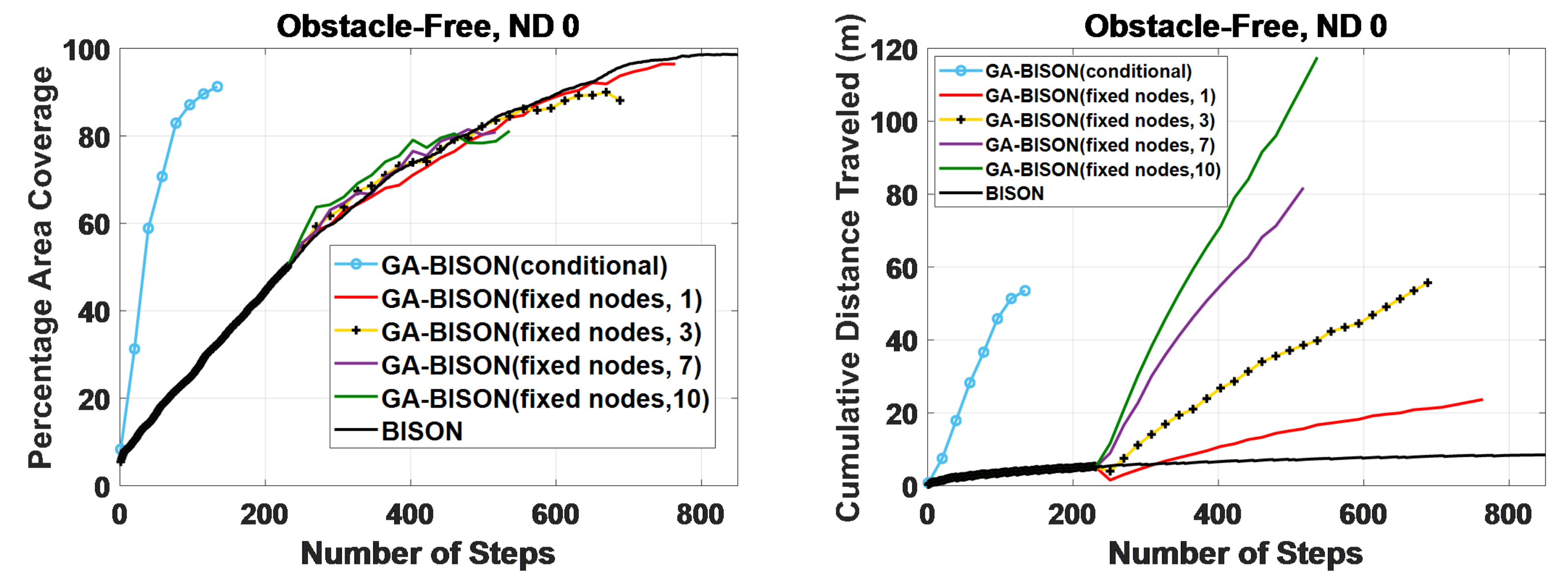
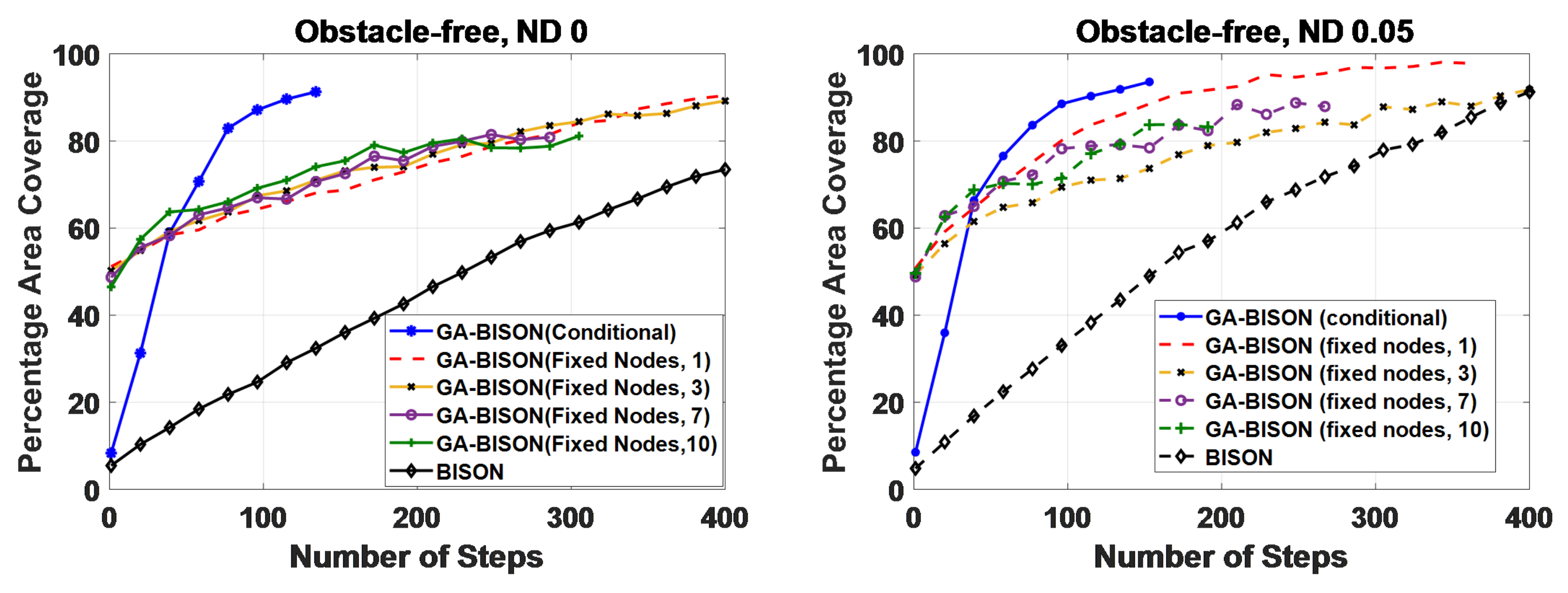
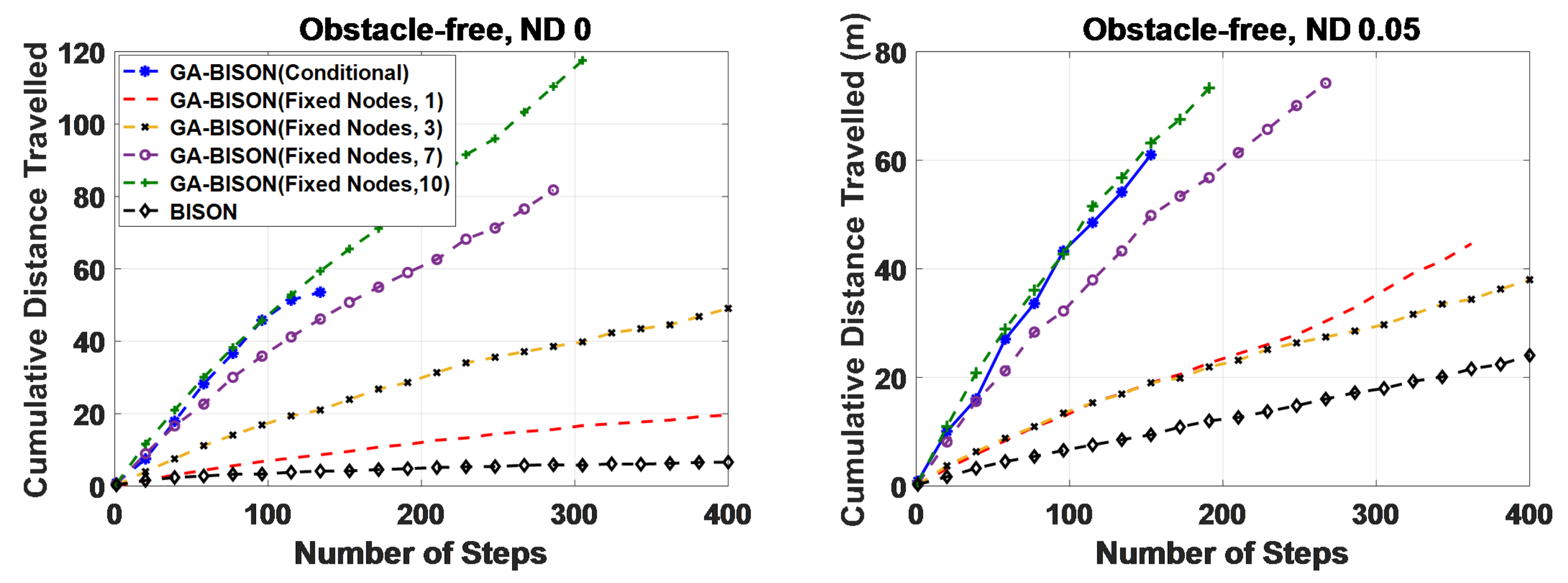
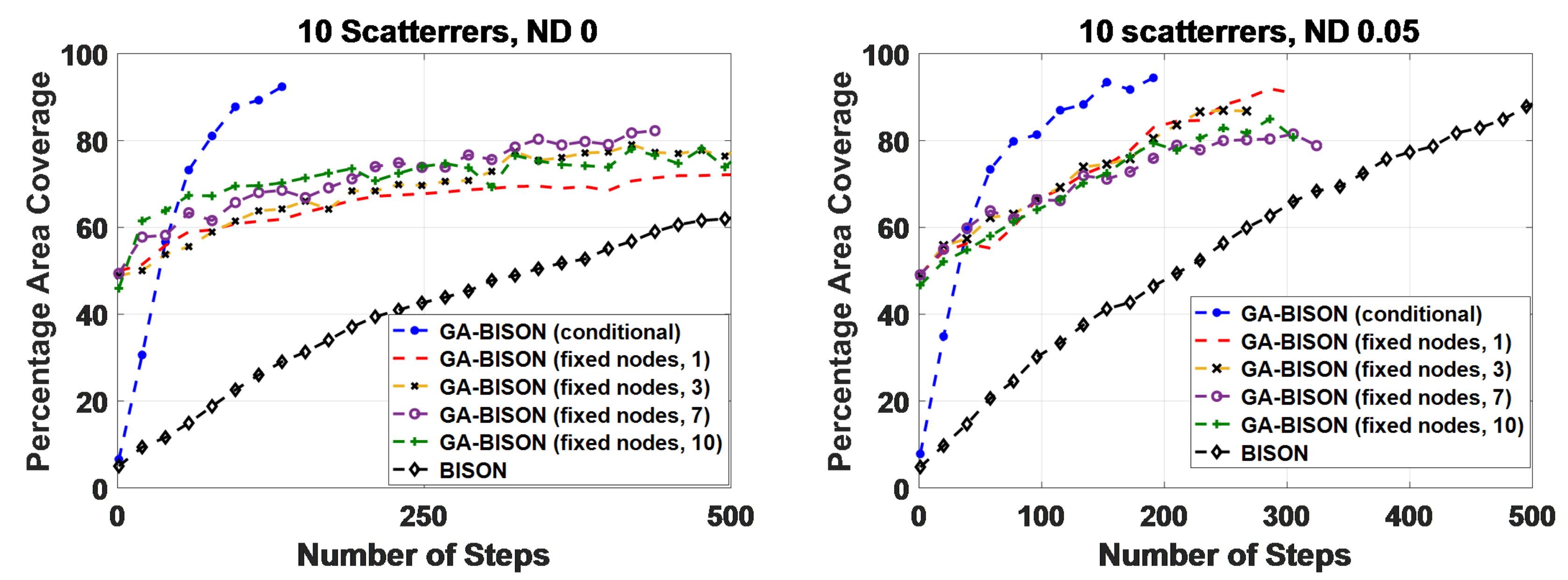
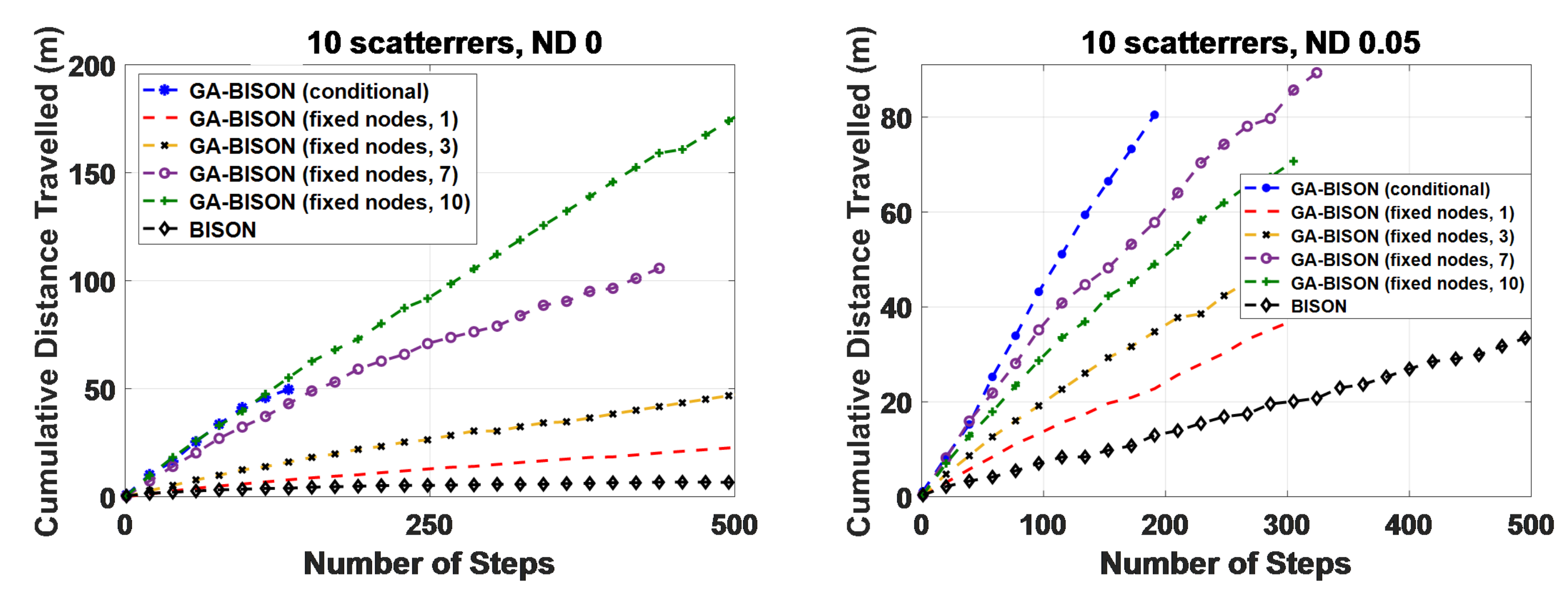
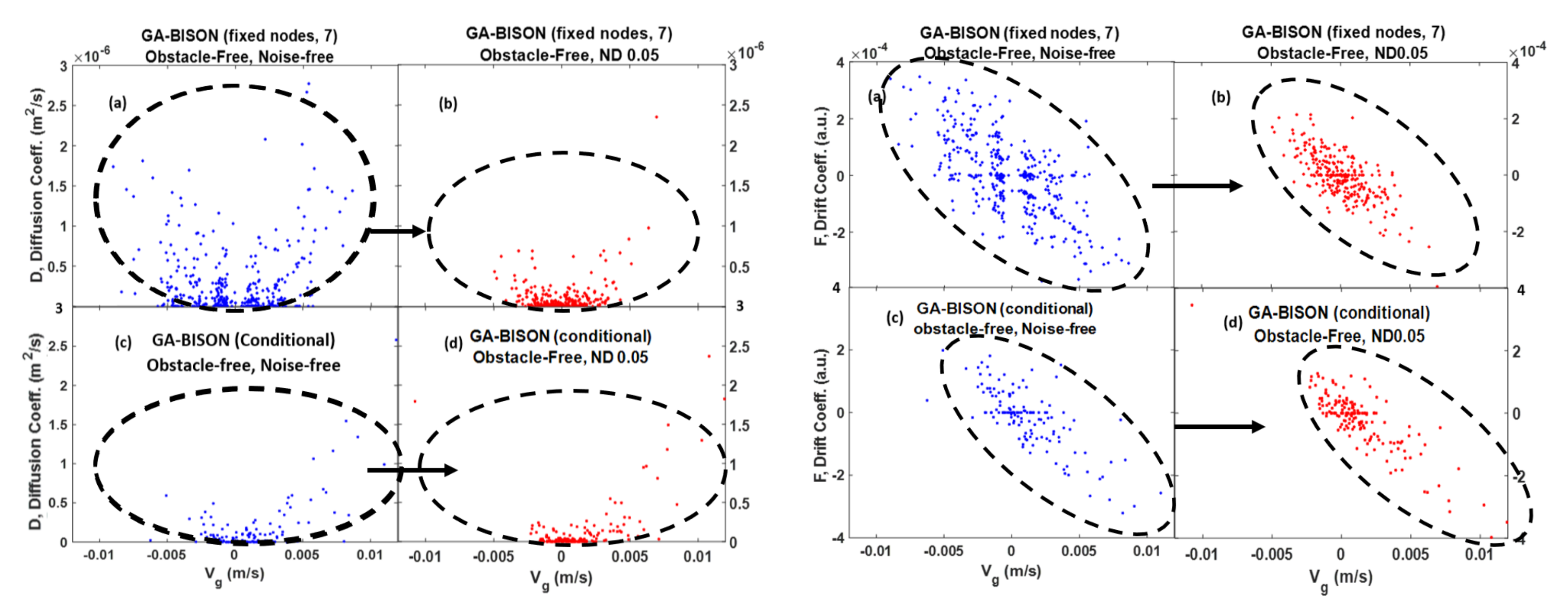
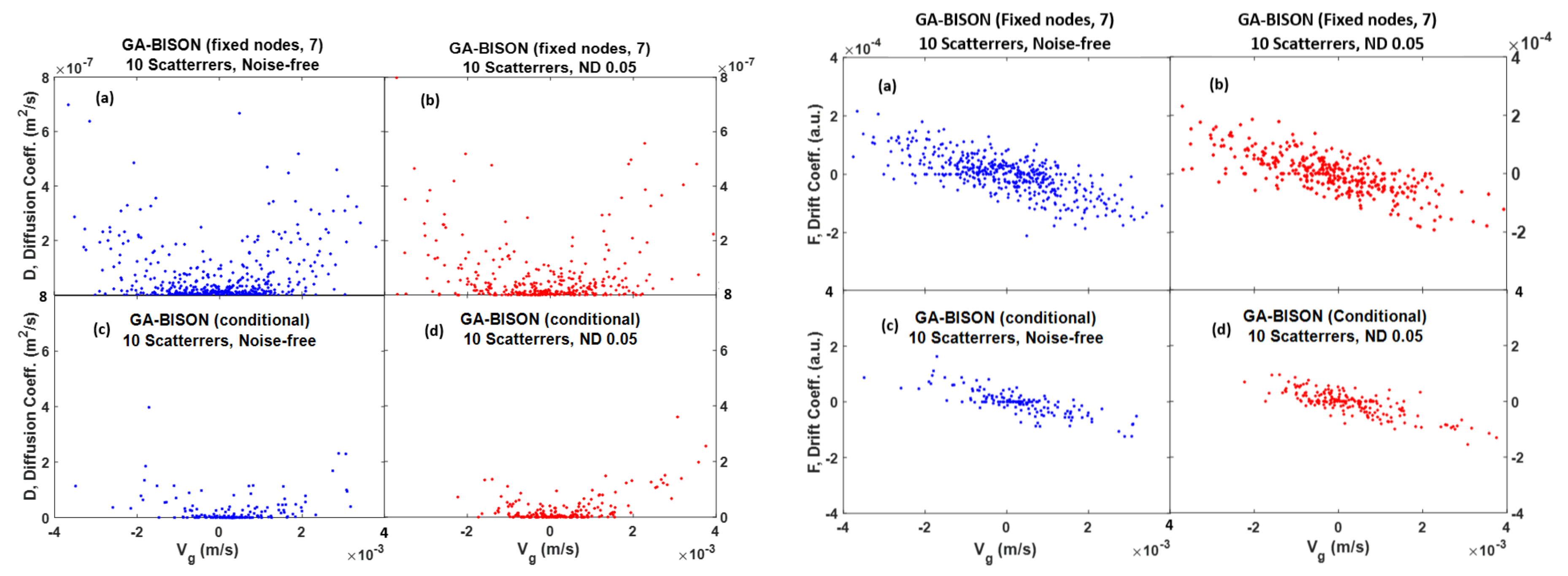
| Reference | WAN | RS | RTM | SAR | GL | INT | SI |
|---|---|---|---|---|---|---|---|
| [12] | ✓ | ✓ | ✓ | ✓ | |||
| [13] | ✓ | ✓ | |||||
| [14] | ✓ | ✓ | ✓ | ✓ | |||
| [15] | ✓ | ||||||
| [16] | ✓ | ||||||
| [17] | ✓ | ||||||
| [18] | ✓ | ✓ | ✓ | ✓ | ✓ | ✓ | ✓ |
| Symbol | Meaning/Usage | Introduced/Used in |
|---|---|---|
| the set of nodes in the WSN | Algorithms 2 and 3 on pages 10, 11 | |
| the numbers of neighboring nodes for node i | Equation (1) on page 10 | |
| r | the number of nodes to consider | Algorithm 1 on page 8 |
| the position (location) of a node i | Section 2.3 (or Figure 1 on page 7) | |
| the distance between two locations n and | Equation (1) on page 10 | |
| the communication range of node i | Section 4.1 | |
| the sensing range of node i | Section 2.3 (or Figure 1 on page on page 7) | |
| the area covered by | Section 2.3 (or Figure 1 on page 7) | |
| the Voronoi area of node i | Section 2.3 (or Figure 1 on page 7) | |
| the number of solutions to generate per node | Algorithm 1 on page 8 | |
| control parameter: number of iterations | Algorithm 1 on page 8 | |
| control parameter: mutation rate | Algorithm 1 on page 8 | |
| control parameter: population size | Algorithm 1 on page 8 | |
| threshold (coverage) to trigger the use of the GA | Algorithms 2 and 3 on pages 10, 11 | |
| termination criterion based on node movement | Algorithms 2 and 3 on pages 10, 11 | |
| termination criterion based in coverage improvement | Algorithms 2 and 3 on pages 10, 11 | |
| PAC | Area coverage (in %) | Section 4.2 |
| CDT | The distance travelled by all nodes in the WSN | Section 4.2 |
| the sum of all node movements during a time step | Section 4.2 (to calculate CDT, cf. Equation (3)) |
| Voronoi | Voronoi | Voronoi | |
|---|---|---|---|
| + ACO [78,79,80,81] | + GA [63,64,65,66,67,68,69,70,71,72,73,74,75,76,77] | + PSO [52,56,57,58,59,60,61,62] | |
| METHOD | Voronoi tessellations are used to determine all possible paths in the network. Assuming the | Voronoi tessellations are used to detect coverage holes while the GA/PSO is used to reduce energy consumption and to maximize the lifetime of the network. Specifically, … | |
| cost (length) of all paths is known, ACO is then used to identify the shortest path. | … GA achieves this by generating new candidate solutions (locations), while … | … PSO does generate virtual points, i.e., Voronoi vertices or random boundary points. | |
| PROCESS | This works by assigning weight values to the Voronoi edges to guide the search. | This effectively changes the node distribution as well as adds extra mobile nodes. | Node location and velocity are changed and a node’s sensing range can be changed. |
| IMPACT | This impacts node distribution, weight values as well as the evaluation function. | The objective function is influenced, as are coverage holes (and GA parameters). | Affects virtual points, node location/velocity and the best local/global solution. |
| GA-BISON 1 Nodes | GA-BISON 3 Nodes | GA-BISON 7 Nodes | GA-BISON 10 Nodes | |||||||||
|---|---|---|---|---|---|---|---|---|---|---|---|---|
| PAC | CDT | st | PAC | CDT | st | PAC | CDT | st | PAC | CDT | st | |
| (%) | (m) | (%) | (m) | (%) | (m) | (%) | (m) | |||||
| p | 93.68 | 15.8 | 426 | 94.00 | 50.03 | 467 | 82.68 | 81.15 | 307 | 85.56 | 71.16 | 341 |
| ± | 1.2 | 2.69 | 48.7 | 3.4 | 5.1 | 68 | 2.2 | 12.1 | 53 | 3.13 | 26 | 63 |
| p | 95.78 | 22.7 | 526 | 84.64 | 41.06 | 330 | 85.42 | 108.5 | 440 | 80.27 | 147.6 | 454 |
| ± | 1.4 | 3.27 | 54.1 | 2.3 | 4.2 | 52 | 3.1 | 14.8 | 62 | 2.05 | 32 | 71 |
| p | 96.87 | 23.62 | 545 | 90.42 | 56.82 | 467 | 80.84 | 81.17 | 293 | 80.9 | 121.6 | 316 |
| ± | 1.9 | 4.06 | 56.3 | 2.9 | 5.5 | 63 | 1.6 | 12.1 | 48 | 2.21 | 28 | 56 |
| # | 96.87 | 23.14 | 545 | 90.42 | 56.82 | 467 | 80.84 | 81.17 | 293 | 80.9 | 121.6 | 316 |
| ± | 1.7 | 2.5 | 49 | 4.5 | 14.6 | 77 | 2.58 | 15.9 | 28 | 0.61 | 27 | 16 |
| # | 93.8 | 16.15 | 418 | 80.92 | 23.75 | 273 | 87.98 | 99.74 | 397 | 82.15 | 59.69 | 273 |
| ± | 1.2 | 1.6 | 42 | 4.1 | 9.6 | 58 | 3.47 | 17.8 | 36 | 1.11 | 13 | 14 |
| # | 98.2 | 18.9 | 600 | 92.67 | 56.31 | 532 | 83.3 | 54.65 | 351 | 82.41 | 63.99 | 301 |
| ± | 1.7 | 1.8 | 70 | 4.7 | 14.4 | 103 | 2.92 | 13.7 | 31 | 1.24 | 16 | 15 |
| m | 96.87 | 23.67 | 545 | 90.42 | 56.82 | 467 | 80.84 | 81.17 | 293 | 80.9 | 121.6 | 316 |
| ± | 1.8 | 1.5 | 71 | 1.2 | 3.65 | 19 | 1.06 | 9.6 | 30 | 1.16 | 17 | 34 |
| m | 93.6 | 20.61 | 429 | 92.95 | 52.66 | 489 | 83.6 | 71.4 | 272 | 83.59 | 129.8 | 359 |
| ± | 1.5 | 1.2 | 66 | 1.3 | 2.9 | 23 | 2.04 | 7.4 | 28 | 1.94 | 19 | 37 |
| m | 92.69 | 20.09 | 399 | 93.14 | 55.99 | 530 | 81.58 | 97.84 | 351 | 81.06 | 87.98 | 421 |
| ± | 1.3 | 1.2 | 54 | 1.4 | 3.61 | 26 | 1.49 | 10.4 | 33 | 1.57 | 14 | 39 |
| Discovery Rate | Coverage | Noise Tolerance | Energy Demands | ||
|---|---|---|---|---|---|
| BISON with GA | (conditional) | fast | low to moderate | robust | high |
| (fixed nodes) | low to moderate | moderate | moderate | moderate to high | |
| BISON | low | high | high | low | |
© 2020 by the authors. Licensee MDPI, Basel, Switzerland. This article is an open access article distributed under the terms and conditions of the Creative Commons Attribution (CC BY) license (http://creativecommons.org/licenses/by/4.0/).
Share and Cite
Eledlebi, K.; Hildmann, H.; Ruta, D.; Isakovic, A.F. A Hybrid Voronoi Tessellation/Genetic Algorithm Approach for the Deployment of Drone-Based Nodes of a Self-Organizing Wireless Sensor Network (WSN) in Unknown and GPS Denied Environments. Drones 2020, 4, 33. https://doi.org/10.3390/drones4030033
Eledlebi K, Hildmann H, Ruta D, Isakovic AF. A Hybrid Voronoi Tessellation/Genetic Algorithm Approach for the Deployment of Drone-Based Nodes of a Self-Organizing Wireless Sensor Network (WSN) in Unknown and GPS Denied Environments. Drones. 2020; 4(3):33. https://doi.org/10.3390/drones4030033
Chicago/Turabian StyleEledlebi, Khouloud, Hanno Hildmann, Dymitr Ruta, and A. F. Isakovic. 2020. "A Hybrid Voronoi Tessellation/Genetic Algorithm Approach for the Deployment of Drone-Based Nodes of a Self-Organizing Wireless Sensor Network (WSN) in Unknown and GPS Denied Environments" Drones 4, no. 3: 33. https://doi.org/10.3390/drones4030033
APA StyleEledlebi, K., Hildmann, H., Ruta, D., & Isakovic, A. F. (2020). A Hybrid Voronoi Tessellation/Genetic Algorithm Approach for the Deployment of Drone-Based Nodes of a Self-Organizing Wireless Sensor Network (WSN) in Unknown and GPS Denied Environments. Drones, 4(3), 33. https://doi.org/10.3390/drones4030033





